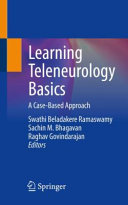TeleNeurology 1st Edition by Randall Wright ISBN 9780323826198 0323826199
$50.00 Original price was: $50.00.$25.00Current price is: $25.00.
TeleNeurology 1st Edition by Randall Wright – Ebook PDF Instant Download/Delivery: 9780323826198 ,0323826199
Full download TeleNeurology 1st Edition after payment

Product details:
ISBN 10: 0323826199
ISBN 13: 9780323826198
Author: Randall Wright
In today’s changing medical climate, more physicians than ever before are incorporating telemedicine into their clinical practice. Teleneurology provides comprehensive, practical answers to the many questions clinicians have on implementing and growing a teleneurology practice. Covering everything from historical perspectives to future possibilities in this evolving field, it provides the information you need to successfully use this promising new option in providing optimal and adaptable patient care.
-
Covers all aspects of practical implementation including technology requirements, legal requirements, and billing concerns.
-
Provides a thorough discussion of how to perform a neurological exam via telemedicine, including links to view real-world examples and find updated regulatory information.
-
Reviews teleneurological evaluation for various disorders including stroke, epilepsy, and movement disorders.
-
Enhanced eBook version included with purchase. Your enhanced eBook allows you to access all of the text, figures, and references from the book on a variety of devices.
TeleNeurology 1st Edition Table of contents:
1
Responding to a crisis: A call to action
Introduction
Virtual foundation
COVID-19
Training
Communication
Virtual urgent care
Patient feedback
Physician feedback
Conclusion
2
The telemedicine exam general overview
The virtual visit
Technical aspects of the virtual visit
References
3
The TeleStroke evaluation
Reference
4
Telemedicine for evaluation of clinical epilepsy
Introduction
Opportunities in virtual epilepsy care
Initial epilepsy history and physical examination
Previsit preparation
The successful virtual consultation
Evaluation and ongoing management
Summary
References
5
The ophthalmologic exam
Introduction
Patient selection
Scheduling visits
Software and hardware technology solutions
The traditional ophthalmic exam
Visual acuity
Pupil exam
Ocular motility
Visual field
Intraocular pressure
External exam (eyelids and globe position in the orbit)
Anterior segment exam
Fundus or retina exam
The hybrid telemedicine model
Home monitoring
Conclusion
References
6
Neuro-ophthalmology evaluation
Introduction
Preparing for a telehealth visit
The virtual visit
History
Physical exam
Management: Counseling and treatment
Conclusion
References
7
Teleneurology for Parkinson’s disease and movement disorders in the COVID-19 pandemic
Introduction
Telemedicine in your movement disorder practice
Conclusions
References
8
Introduction to tele-psychology during the pandemic
9
Tele-neuropsychology: Bringing neuropsychology into the future of health care delivery
Patient satisfaction
Research in tele-neuropsychology
Adults
Pediatrics
Tele-NP models
Connecting” with the patient
Improving clinical outcomes
Improving tele-NP visits
Consent form
Neuropsychological reports
Billing tele-NP
Interstate practice
Future of tele-NP
Resources
Summary
References
10
Sleep telemedicine
Overview
Sleep telemedicine diagnostic approaches
Tips when taking a sleep history and performing the sleep-oriented exam
Sleep telemedicine treatment approaches
Telemedicine follow-up approaches
Conclusion
References
11
Neuromuscular evaluation
The history of telemedicine
Telemedicine in neurology
Telemedicine in neuromuscular disease
Telemedicine in ALS
Telemedicine in neurology in the COVID-19 era
Telemedicine in neuromuscular medicine in the COVID-19 era
The Virtual Examination of the Neuromuscular Patient
Conclusion
References
12
General neurosurgery exam
Introduction
Introductory interview questions
Mental status
Alertness
Orientation
Level of consciousness
Troubleshooting the GCS examination via telecommunication
Speech
Cranial nerve exam
A special note on cranial nerve III and VI palsies
Strength exam
General strength exam
Pronator drift
Examination of the spine
The Babinski reflex
Sensory exam
Coordination
Dysdiadochokinesia
Dysmetria
Conclusions
References
13
Neurosurgical spine care during COVID-19 pandemic: The Department of Neurological Surgery Houston Methodist experience
Introduction
Our approach
The visit
Evaluation/examination
Diagnosis
Treatment
Limits of telemedicine
Conclusion
References
14
System coordination and implementation
Core values should guide decisions
Case 1: Dr. Garcia needs help at the hospital
Questions to consider for Case 1
Discussion
Solutions and realignment
Takeaways
Case 2: The call volume is increasing
Questions to consider for Case 2
Discussion
Solutions and realignment
Takeaways
Case 3: System-wide adoption
Questions to consider for Case 3
Discussion
Solutions and realignment
Takeaways
Summary
References
15
Teleneurology in academics
Introduction to virtual care within graduate medical education
Trainee perspective on telemedicine
Teaching faculty perspective on telemedicine
Clinical
Academics
Research
Administrative
Final thoughts from trainee and mentee
References
16
Telehealth laws, regulations, and reimbursement
Introduction
Licensure
Practice standards
Payment
Medicare
The role of advocacy
References
Further reading
17
International teleneurology
Background
The burden of neurological disorders
Clinical care
International telestroke networks
Other medical specialties
Teleneurology toward a preventive medicine and interdisciplinary approach
Telemedicine programs in underserved areas
Humanitarian crisis
Education
Conclusion
References
18
Future of telemedicine
Background/past implementation
Current environment
Future development and adoption
References
People also search for TeleNeurology 1st Edition:
sevaro health teleneurology
teleneurology jobs salary
teleneurology locums
teleneurology mgh
teleneurology nurse practitioner
Tags: Randall Wright, TeleNeurology
You may also like…
Romance - Young Adult Romance
Fantasy - Other Fantasy Fiction Categories
To make a hero 1st Edition by Randall Garrett ISBN 9362094517 9789362094513
Animals & Pets - Field Guides
Business & Economics - Personal Finance
Romance - Contemporary Romance
Romance - Interracial
Adrian (Filthy Rich Alphas #1) 1st Edition Kenya Wright [Wright
Romance - Contemporary Romance
Wright That Got Away Wright Vineyard 4 1st Edition K A Linde
Uncategorized
Learning Teleneurology Basics A Case Based Approach 1st Edition Swathi Beladakere Ramaswamy












